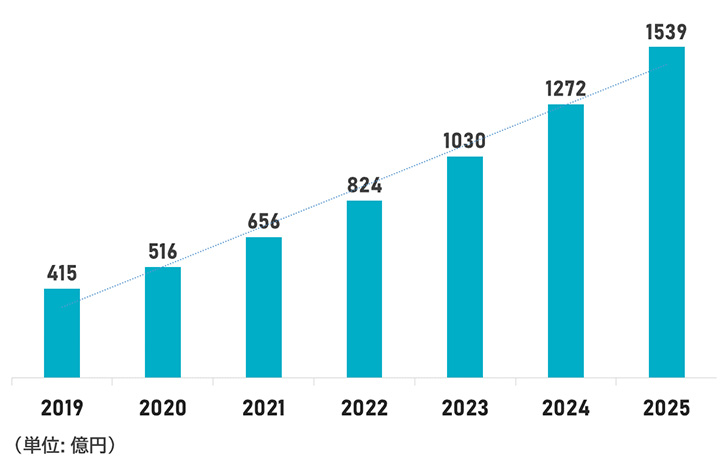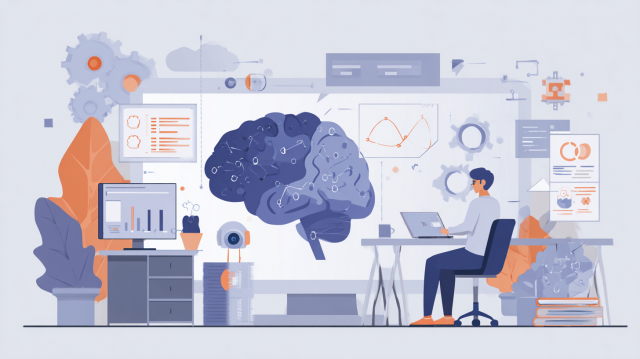
No-code, which has been gaining attention in the IT field in recent years. Amidst a shortage of IT personnel, it is attracting attention as a method to develop applications without programming knowledge.
This article introduces the meaning of no-code, as well as no-code AI platforms for AI implementation, and also presents growth forecast data for the future no-code market.
- Table of Contents
-
- 1. What is No-Code?
- 1-1. What No-Code Means
- 1-2. What is Low Code?
- 1-3. A Surprisingly Long History of No-Code
- 1-4. Addressing Diversity in Society with No-Code
- 2. No-Code/Low-Code Market Forecast for 2023
- 2-1. Growing No-Code/Low-Code Development Market
- 3. Addressing the Shortage of AI Talent with No-Code Solutions
- 80% of companies are facing a shortage of IT personnel
- 3-2. Growing Demand for AI Talent
- 3-3. No-Code as a Measure Against Talent Shortages
- 3-4. Concerns about No-Code
- 4. Introduction to No-Code AI Platforms
- 4-1. What is a No-Code AI Platform?
- 4-2. Learning Center
- 4-3. No-Code AI Development Tool Node-AI
- 4-4. MatrixFlow
- 5. AI Consultations with Human Science
- 5-1. 48 million items of training data created
- 5-2. Resource management without crowdsourcing
- 5-3. The latest data annotation tools
- 5-4. Secure room in office
1. What is No-Code?

1-1. What No-Code Means
The term "No Code" first appeared in a blog post published in 2019. In the article titled "The Rise of 'No Code'", the term is used to refer to methods and services for developing applications solely through screen operations without writing code. Until now, developing applications required learning coding or programming first. However, by utilizing no-code tools, a wide range of people, not just IT professionals, can participate in application development.
>>The Rise of “No Code” (English)
1-2. What is Low Code?
Another term that is often seen alongside no-code is low code. In contrast to no-code, which involves not writing any code at all, low code refers to a method of developing applications with as little coding as possible.
1-3. A Surprisingly Long History of No-Code
The terms no-code and low-code have emerged recently, but looking back at the history of computers, it is clear that efforts towards no-code and low-code have been ongoing for a long time. Many engineers and programmers have repeatedly experimented to develop applications with as little programming as possible. Throughout this evolution, programming has been streamlined, leading to the creation of software and services that allow users to operate computers solely through graphical interfaces, which is now commonplace. Microsoft Excel is also a product of these efforts.
1-4. Addressing Diversity in Society with No-Code
As people's interests and working styles diversify, customer needs have also become more complex and individualized in recent years, requiring companies to constantly pursue new initiatives. To adapt to the diversity of society and sustain business, a method that involves investing small amounts while nurturing many services and products at a faster pace than before is needed, rather than the traditional approach of investing large capital for significant returns. This kind of initiative pairs exceptionally well with no-code solutions. With no-code, it becomes possible to explore fields that were previously untapped while keeping operational costs low. The speed from development to release, which is a characteristic of no-code, also helps in seizing business opportunities without missing out.
2. No-Code/Low-Code Market Forecast for 2023

2-1. Growing No-Code/Low-Code Development Market
Let's take a look at the development scale trends in the domestic no-code/low-code development market from 2019 and the forecasts up to 2025.

Source: ITR "ITR Market View: Low-Code/No-Code Development Market 2022" created by the author
*Targets vendor sales scale for the March quarter. Forecast values from 2021 onwards.
The market is expected to grow at a rate exceeding 20% annually, reaching a scale of 100 billion yen in the fiscal year 2023. It can be said that many companies are beginning to recognize the ease of maintenance and the benefits of in-house development that are characteristic of no-code/low-code solutions.
3. Addressing the Shortage of AI Talent with No-Code Solutions
One reason why no-code, which should have been a common methodology until now, is gaining attention is the shortage of human resources. There is a lack of IT personnel who possess specialized skills such as programming.
80% of companies are facing a shortage of IT personnel
Let's take a look at the data from a survey conducted in 2020 targeting domestic IT companies, regarding the perceived surplus or shortage of IT personnel.

Source: IPA "Survey on Skill Transformation in the Digital Age" April 22, 2021, created by the author from the "IT Human Resources White Paper"
Combining those who feel "significantly lacking" and "somewhat lacking," it is clear that over 80% of companies are experiencing a shortage of IT personnel. This survey targets IT companies, but nowadays, in any industry, having IT knowledge is often necessary to realize new ideas in business. IT personnel can be considered essential staff. However, the current situation is that the supply does not meet the demand. Even if existing personnel acquire specialized knowledge to become IT personnel, it takes time and cost.
3-2. Growing Demand for AI Talent
The layer referred to as AI talent, which embodies AI, is also IT talent. Due to the AI boom, IT talent, which was already in short supply, has also taken on the role of developing AI, creating an increasingly heated situation of labor shortages. There are two typical roles of AI talent as follows.
・Data Scientist
A data scientist refers to a role that analyzes data based on statistics and algorithms to create value and solve problems. In AI development, the challenge is to perform appropriate analysis and classification from vast amounts of data and to identify the role that this data plays in improving the accuracy of AI.
・AI Engineer
Also known as ML (Machine Learning) Engineer. This role involves actually performing machine learning, which is essential for AI development, and building the systems that enable AI to function.
These AI professionals require knowledge of mathematics and statistics, as well as programming skills to implement AI in real-world environments. It seems that many companies face various difficulties, such as the challenge of finding talent quickly and issues with compensation even when they do find suitable candidates.
3-3. No-Code as a Measure Against Talent Shortages
No-code is gaining attention as a way to improve such situations.
No-code tools can be used with general IT knowledge. Until now, it has always been necessary to secure IT personnel regardless of the scale or complexity of the system to be built. However, by utilizing no-code tools, it becomes possible to address small-scale ideas or situations where a simple system is sufficient with just the existing personnel.
In situations such as creating prototype models or digitizing for business improvement, no-code can be a great help.
3-4. Concerns about No-Code
In principle, no-code tools can only utilize the features provided within the specified range. Since they are not suitable for customization, they may not be practical when you want to create a unique system. Additionally, while programming skills are not essential, general IT knowledge will likely be necessary.
4. Introduction to No-Code AI Platforms

4-1. What is a No-Code AI Platform?
No-code AI is a method of building AI by combining pre-prepared parts, similar to assembling components without programming. To implement no-code AI, it is common to use services from no-code AI platforms. Here are some actual examples.
4-2. Learning Center
This service features an intuitive and user-friendly Japanese UI, allowing anyone to easily develop high-precision AI models without coding. No specialized knowledge in AI or programming is required, and you can manage data, automatically generate AI, and distribute it through simple inputs and clicks.
>>AI inside launches "Learning Center," enabling high-precision AI model development with no code
4-3. No-Code AI Development Tool Node-AI
As the name suggests, it is a no-code AI development tool that allows you to intuitively connect modules from your browser, enabling you to create and execute a complete pipeline from preprocessing time series data to training and evaluating AI models.
>>Introduction to the No-Code AI Development Tool Node-AI
4-4. MatrixFlow
This is a machine learning platform that allows you to create AI that can be utilized in your company's operations, performing data analysis, image recognition, and numerical predictions using AI, even without knowledge of programming languages like Python or specialized knowledge. With MatrixFlow, you can build AI without programming.
>>What is MatrixFlow? A thorough explanation of how to use MatrixFlow and how to use it for free
5. AI Consultations with Human Science
5-1. 48 million items of training data created
"I want to implement AI, but I don’t know where to start."
"I don’t know what to request, even if I outsource."
If your company is struggling with either of these issues, please feel free to contact Human Science. Our company has been involved in AI model development projects across various industries, starting with natural language processing and extending to medical support, automobiles, IT, manufacturing, and construction, just to name a few. Through direct business with many companies, including GAFAM, we have provided over 48 million pieces of high-quality training data. No matter the industry, our team is prepared to handle anything from small-scale annotation projects to long-term ventures with 150 annotators.
>> Human Science’s Annotation Services
5-2. Resource management without crowdsourcing
At Human Science, we do not use crowdsourcing. Instead, projects are handled by personnel who are contracted with us directly. Based on a solid understanding of each member's practical experience and their evaluations from previous projects, we form teams that can deliver maximum performance.
5-3. The latest data annotation tools
One of the annotation tools introduced by Human Science is AnnoFab, which lets you receive progress checks and customer feedback on the cloud, even while the project is ongoing. By ensuring that work data cannot be saved on local machines, we demonstrate appropriate security measures.
5-4. Secure room in office
Human Science has a secure room that meets ISMS standards within our Shinjuku office, so we can handle even highly confidential projects on-site. The promise of of confidentiality is extremely important to us for any of our projects. We provide continuous security training to our staff, and we handle all information and data with the utmost care, even on remote projects.

 Text Annotation
Text Annotation Audio Annotation
Audio Annotation Image & Video Annotation
Image & Video Annotation Generative AI, LLM, RAG Data Structuring
Generative AI, LLM, RAG Data Structuring
 AI Model Development
AI Model Development In-House Support
In-House Support For the medical industry
For the medical industry For the automotive industry
For the automotive industry For the IT industry
For the IT industry




























































































